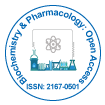
Biochemistry & Pharmacology: Open Access
Open Access
ISSN: 2167-0501

ISSN: 2167-0501
Michiko N. Fukuda
Sanford-Burnham-Prebys Medical Discovery Institute, USA
Scientific Tracks Abstracts: Biochem Pharmacol (Los Angel)
It is widely accepted that surfaces of the vasculature express varying tissue-specific receptors under different pathological conditions1. Oh et al. used subtractive proteomics analysis of malignant vs. normal vasculature to identify Annexin A1 (ANXA1) as a highly specific surface marker of malignant tumor vasculature 2, 3. Independently, in mouse studies we reported that IF7 peptide, IFLLWQR, which binds the ANXA1 N-terminus, functions as a tumor vasculature-targeted drug delivery vehicle after intravenous injection4-6. To enhance IF7 stability in vivo, we undertook mirror-image peptide phage display using a synthetic D-peptide representing the ANXA1 N-terminus as target. We then identified candidate L-peptide sequences, synthesized them using D-amino acids, and found that one peptide bound to the L-ANXA1 N-terminus. We designated that peptide dTIT7. When we injected mouse brain tumor models with near infrared fluorescent-conjugated dTIT7, whole body imaging revealed fluorescent signals in brain and kidney. Significantly, oral administration of a dTIT7/geldanamycin (GA) conjugate suppressed brain tumor growth7 in these models. Also, given that IF7 peptide is stable in human blood for >10 minutes and that, when injected, IF7/SN38 rapidly targets tumor vasculature, we sought to optimize its activity as an orally-administrable drug. To do so, we screened phage displayed libraries for a peptide to facilitate gut-toblood IF7 transfer. The resulting decapeptide, CVK10, when orally administered to mice together with the IF7/SN38 conjugate promoted IF7/SN38 gut-to-blood transfer and showed tumor targeting capacity superior to that of IF7/SN38 alone with no overt side effects. Overall, these lines of evidence indicate that peptides can be developed as orally-administrable tumor vasculature-targeting therapeutics suitable for clinical application
Recent Publications:
1. Ruoslahti E, Rajotte D. An address system in the vasculature of normal tissues and tumors. Annu Rev Immunol. 2000; 18:813–27.
2. Oh P, Li Y, Yu J, Durr E, Krasinska KM, Carver LA, et al. Subtractive proteomic mapping of the endothelial surface in lung and solid tumours for tissue-specific therapy. Nature. 2004; 429(6992):629– 35.
3. Oh P, Testa JE, Borgstrom P, Witkiewicz H, Li Y, Schnitzer JE. In vivo proteomic imaging analysis of caveolae reveals pumping system to penetrate solid tumors. Nat Med. 2014; 20:1062–8.
4. Hatakeyama S, Sugihara K, Shibata TK, Nakayama J, Akama TO, Tamura N, et al. Targeted drug delivery to tumor vasculature by a carbohydrate mimetic peptide. Proc Natl Acad Sci U S A. 2011; 108:19587–92.
5. Nonaka M, Suzuki-Anekoji M, Nakayama J, Mabashi-Asazuma H, Jarvis DL, Yeh JC, et al. Overcoming the blood-brain barrier by Annexin A1-binding peptide to target brain tumours. Br J Cancer. 2020; 123:1633–43.
6. Fukuda MN, Nonaka, M, Anekoji MS, CNS Malignancy. IntechOpen; 2021.
7. Nonaka M, Mabashi-Asazuma H, Jarvis DL, et al. Development of an orally-administrable tumor vasculature-targeting therapeutic using annexin A1 binding D-peptides. PLOS ONE. PLoS One. 2021;16:e0241157.
Michiko N.Fakuda has her expertise in evaluation and passion in improving the health and wellbeing. Her open and contextual evaluation model based on responsive constructivists creates new pathways for improving healthcare. She has built this model after years of experience in research, evaluation, teaching and administration in education institutions which is a methodology that utilizes the previous generations of evaluation: measurement, description and judgment. It allows for value-pluralism. This approach is responsive to all stakeholders and has a different way of focusing.